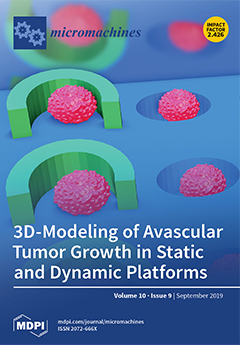Open AccessArticle
An Integrated Portable Multiplex Microchip Device for Fingerprinting Chemical Warfare Agents
by
Karolina Petkovic, Anthony Swallow, Robert Stewart, Yuan Gao, Sheng Li, Fiona Glenn, Januar Gotama, Mel Dell’Olio, Michael Best, Justin Doward, Simon Ovendon and Yonggang Zhu
Cited by 11 | Viewed by 3330
Abstract
The rapid and reliable detection of chemical and biological agents in the field is important for many applications such as national security, environmental monitoring, infectious diseases screening, and so on. Current commercially available devices may suffer from low field deployability, specificity, and reproducibility,
[...] Read more.
The rapid and reliable detection of chemical and biological agents in the field is important for many applications such as national security, environmental monitoring, infectious diseases screening, and so on. Current commercially available devices may suffer from low field deployability, specificity, and reproducibility, as well as a high false alarm rate. This paper reports the development of a portable lab-on-a-chip device that could address these issues. The device integrates a polymer multiplexed microchip system, a contactless conductivity detector, a data acquisition and signal processing system, and a graphic/user interface. The samples are pre-treated by an on-chip capillary electrophoresis system. The separated analytes are detected by conductivity-based microsensors. Extensive studies are carried out to achieve satisfactory reproducibility of the microchip system. Chemical warfare agents soman (GD), sarin (GB), O-ethyl S-[2-diisoproylaminoethyl] methylphsophonothioate (VX), and their degradation products have been tested on the device. It was demonstrated that the device can fingerprint the tested chemical warfare agents. In addition, the detection of ricin and metal ions in water samples was demonstrated. Such a device could be used for the rapid and sensitive on-site detection of both chemical and biological agents in the future.
Full article
(This article belongs to the Special Issue
IMCO 2019)






